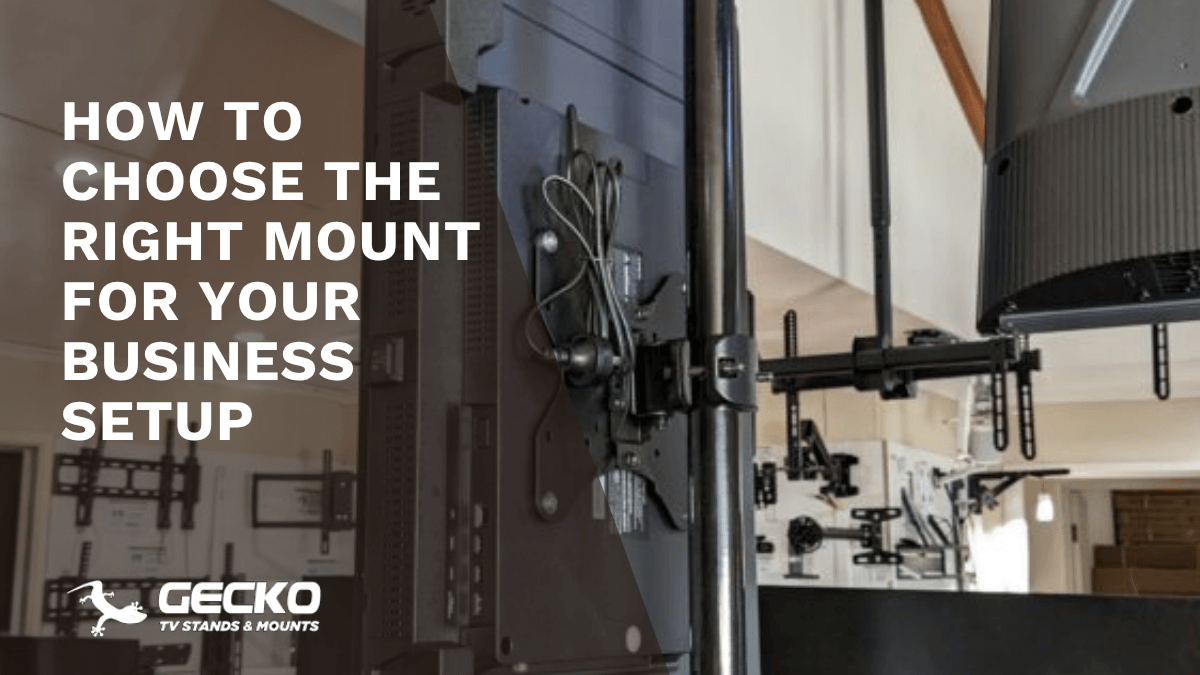How to Choose the Right Mount for Your Business Setup

A practical, no-nonsense guide for choosing the right commercial mount in 2025
Most businesses pick a TV mount the same way they pick a HDMI cable — quick Google search, cheapest option, done. Then the problems start: screens sag, brackets wobble, cables hang out, the screen sits too high, or a tradie shows up and says, “Mate, this thing’s not designed for this wall.”
Commercial spaces aren’t like living rooms. You’ve got safety requirements, hard-working screens, unpredictable traffic flow and real liability if something falls.
This guide walks through the simple, practical steps that actually matter when choosing a mount for your business.
Step 1: Get clear on your use case
Every business layout is different — the mount must match the job, not just the screen.
Common scenarios:
Offices / Meeting Rooms
- Need adjustability
- Clean look
- Easy access to portsInternal link: /full-motion-mounts
Retail Spaces
- Low-profile mounts
- Harder to tamper with
- Fixed or tilt for signageInternal link: /tilt-tv-mounts
Cafés / Restaurants
- High visibility
- Overhead or angled viewing
- Ceiling mounts are idealInternal link: /ceiling-mounts
Gyms / Fitness Studios
- Heavy screens
- Vibration resistance
- Strong extension for high walls
Schools & Training Centres
- Mobile stands for multi-room useInternal link: /mobile-tv-stands
Once the use case is clear, the rest falls into place.
Step 2: Match screen size & VESA pattern
Every screen has a VESA pattern — the hole spacing on the back.
Mounts don’t care about brand; they care about VESA.
Why it matters:
- Wrong VESA = the mount simply won’t work
- Larger displays often need reinforced brackets
- Load capacity must include the mount + cables + accessories
Rule of thumb:
Choose a mount that is rated for at least 20–30% above your combined screen weight.
Most commercial failures happen because people choose mounts with just enough capacity.
Step 3: Pick the right mount type
Here’s the cheat sheet.
Fixed Mount
- Cheapest
- Strongest
- Perfect for simple signageInternal link: /fixed-mounts
Tilt Mount
- Best for overhead or high wall installs
- Reduces glare
- Great for menus and retail signage
Full-Motion (Articulating) Mount
- Ideal for meeting rooms, offices, gyms
- Best flexibility (swivel, tilt, extend)
Ceiling Mount
- Perfect when wall space is limited
- Great for restaurants and open spaces
Video Wall Mount
- Tool-less pop-out options for maintenance
- Designed for multi-screen commercial displays
Mobile Stand
- Training rooms, classrooms, shared spaces
- Maximum flexibility
Choosing the wrong mount type is what leads to sagging screens, bad viewing angles, and safety risks.
Step 4: Check your installation environment
This is the most overlooked step.
Wall type matters
- Gyprock needs proper anchors
- Brick requires masonry fixings
- Steel studs must be located accurately
- Ceiling mounts require structural support (no exceptions)
Cable paths matter
Poor cable access = ugly installs or unsafe tension.
Plan for:
- Power outlet location
- HDMI/AV routing
- Concealment options
- Future upgrades
Viewing height & angle
Businesses almost always mount screens too high.
Ideal rule:
Center of screen at eye level in primary viewing position.
Step 5: Think about safety & compliance
In commercial settings, this is non-negotiable.
What to check:
- Weight capacity with real safety buffer
- Anti-theft features
- Locking mechanism integrity
- Fire safety / compliance where needed
- Proper hardware for wall type
If your screen is in a public area, assume people will bump it, push it or lean on it. Choose accordingly.
Step 6: Align with your budget — without cutting corners
You don’t need the most expensive bracket.
But you can’t go full cheapest-eBay-option either.
What you can get for:
Under $300:
- Tilt mounts
- Fixed mounts
- Smaller full-motion units
$300–$500:
- Heavy-duty full-motion
- Strong ceiling mounts
- Mid-tier stands
$500–$800:
- Premium stands
- Dual-display ceiling systems
- Larger articulating arms
Keep it simple:
Choose the best mount you can within your business risk profile — not the cheapest one available.
Quick decision guide
- Retail? Tilt mount → signage-friendly
- Offices? Full-motion → flexible for presenters
- Gyms? Heavy-duty full-motion → handles vibration
- Cafés/menus? Ceiling mount → visibility & space
- Training rooms? Mobile stand → maximum mobility
- Video walls? Pop-out video wall mount → easy maintenance
Recommended Mount Categories
All Solution TV Mounts
- Television Wall Mounts
- Full Motion TV Mounts
- Ceiling TV Mounts
- Low Profile TV Wall Mounts
- Menu Board Mount (for cafés/restaurants)
- Motorized Mount (premium meeting rooms)
- Floor to Ceiling TV Mount (retail + open spaces)
Commercial TV Cart
- Mobile Stand
- Projector Mount (for training rooms, education)
Related Articles:
The Best Budget-Friendly Commercial Mounts for 2025
Final Wrap-Up
Choosing the right commercial mount isn’t complicated — you just need to match the mount type to your business environment, check your VESA and load requirements, assess the wall or ceiling you’re working with, and keep safety front and centre. Once you get those things right, the installation is smoother, the display performs better, and you avoid the headaches caused by cheap, poorly matched brackets.







